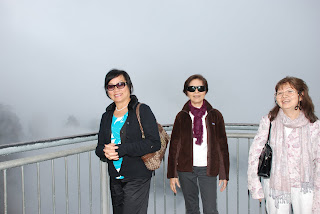


đến Blue Mountain màn sương mù đang bao phủ lóe lên chút ánh mặt trời



anh Tuấn đang chụp hình nhìn lên










The Three Sisters
The Three Sisters is essentially an unusual rock formation representing three sisters who according to Aboriginal legend were turned to stone.
The character of the Three Sisters changes throughout the day and throughout the seasons as the sunlight brings out the magnificent colours. The Three Sisters is also floodlit until around 11pm each evening looking simply spectacular set against the black background of the night sky.
Each of the Three Sisters stand at 922, 918 & 906 metres tall, respectively.
That's over 3000 feet above sea level! The Legend
The Aboriginal dream-time legend has it that three sisters, 'Meehni', 'Wimlah' and Gunnedoo' lived in the Jamison Valley as members of the Katoomba tribe.
These beautiful young ladies had fallen in love with three brothers from the Nepean tribe, yet tribal law forbade them to marry.
The brothers were not happy to accept this law and so decided to use force to capture the three sisters causing a major tribal battle.
As the lives of the three sisters were seriously in danger, a witchdoctor from the Katoomba tribe took it upon himself to turn the three sisters into stone to protect them from any harm. While he had intended to reverse the spell when the battle was over, the witchdoctor himself was killed. As only he could reverse the spell to return the ladies to their former beauty, the sisters remain in their magnificent rock formation as a reminder of this battle for generations to come.
Alternative Legend
Long ago there was a Bunyip who lived in a deep hole who was feared by all.
Passing the hole was considered very dangerous, therefore whenever Tyawan had to pass the hole in search for food, he would leave his daughters safely on the cliff behind a rocky wall.
One fateful day, Tyawan waved goodbye to his daughters and descended down the cliff steps into the valley.
Meanwhile at the top of the cliff, Meenhi was frightened by a large centipede which suddenly appeared before her. Meenhi took a stone and threw it at the centipede. The stone continued on its journey and rolled over the cliff, crashing into the valley below which angered the Bunyip.
The rocky wall behind Meenhi, Wimlah and Gunnedoo then began to split open and the three sisters were left stranded on a thin ledge at the top of the cliff. All the birds, animals and fairies stopped still as the Bunyip emerged to see the terrified girls.
As the Bunyip began to approach the girls, to protect them from harm, their father Tyawan used his magic bone to turn them into stone.
Angered by this, the Bunyip then began to chase Tyawan. Becoming trapped, in order to flee from the Bunyip, Tyawan changed into a magnificent Lyre Bird, yet in the process dropped his magic bone. Tyawan and his three daughters were now safe from the Bunyip.
Once the Bunyip had disappeared, Tyawan returned in search of his magic bone, yet this was never to be found.
The Lyre Bird has been searching for this magic bone ever since. Remaining in rock formation, The Three Sisters stand silently overlooking the valley hoping that one day he'll find the bone and turn them back to former selves.
When visiting The Three Sisters, if you listen carefully you may be able to hear the Lyre Bird, Tyawan, as he continues his quest for his lost magic bone.
Theo Wikipédia

























































